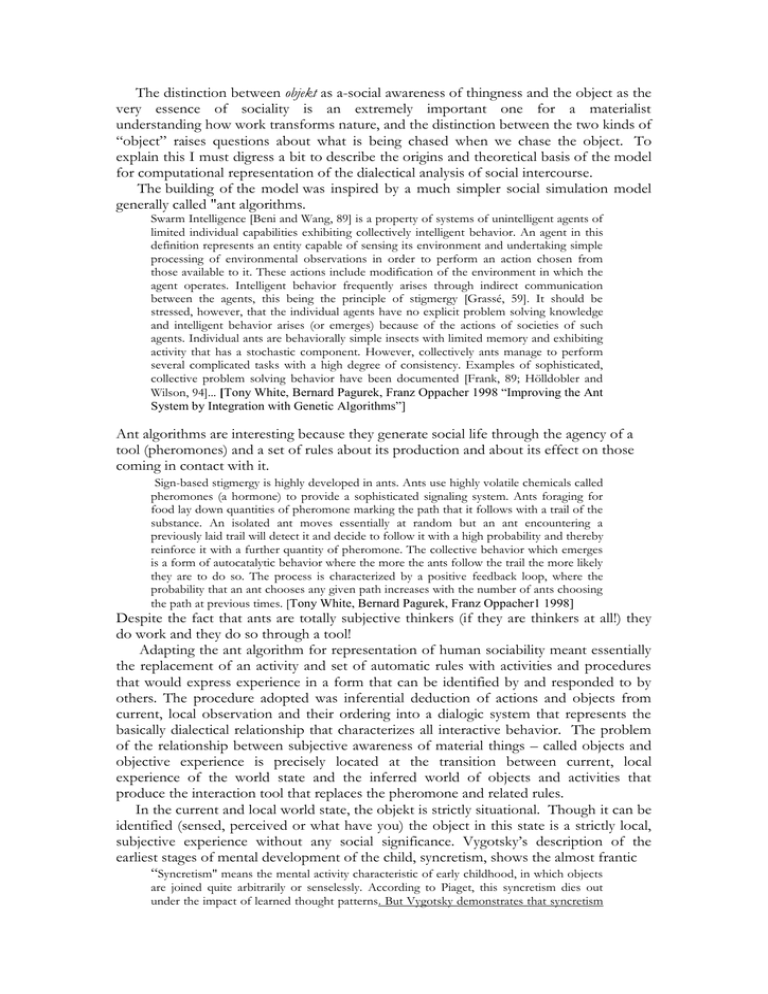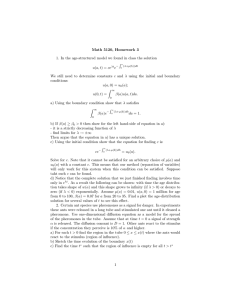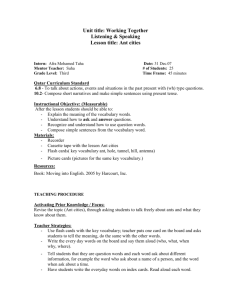objekt very essence of sociality is ... understanding how work transforms nature, and the distinction between the...
advertisement

The distinction between objekt as a-social awareness of thingness and the object as the very essence of sociality is an extremely important one for a materialist understanding how work transforms nature, and the distinction between the two kinds of “object” raises questions about what is being chased when we chase the object. To explain this I must digress a bit to describe the origins and theoretical basis of the model for computational representation of the dialectical analysis of social intercourse. The building of the model was inspired by a much simpler social simulation model generally called "ant algorithms. Swarm Intelligence [Beni and Wang, 89] is a property of systems of unintelligent agents of limited individual capabilities exhibiting collectively intelligent behavior. An agent in this definition represents an entity capable of sensing its environment and undertaking simple processing of environmental observations in order to perform an action chosen from those available to it. These actions include modification of the environment in which the agent operates. Intelligent behavior frequently arises through indirect communication between the agents, this being the principle of stigmergy [Grassé, 59]. It should be stressed, however, that the individual agents have no explicit problem solving knowledge and intelligent behavior arises (or emerges) because of the actions of societies of such agents. Individual ants are behaviorally simple insects with limited memory and exhibiting activity that has a stochastic component. However, collectively ants manage to perform several complicated tasks with a high degree of consistency. Examples of sophisticated, collective problem solving behavior have been documented [Frank, 89; Hölldobler and Wilson, 94]... [Tony White, Bernard Pagurek, Franz Oppacher 1998 “Improving the Ant System by Integration with Genetic Algorithms”] Ant algorithms are interesting because they generate social life through the agency of a tool (pheromones) and a set of rules about its production and about its effect on those coming in contact with it. Sign-based stigmergy is highly developed in ants. Ants use highly volatile chemicals called pheromones (a hormone) to provide a sophisticated signaling system. Ants foraging for food lay down quantities of pheromone marking the path that it follows with a trail of the substance. An isolated ant moves essentially at random but an ant encountering a previously laid trail will detect it and decide to follow it with a high probability and thereby reinforce it with a further quantity of pheromone. The collective behavior which emerges is a form of autocatalytic behavior where the more the ants follow the trail the more likely they are to do so. The process is characterized by a positive feedback loop, where the probability that an ant chooses any given path increases with the number of ants choosing the path at previous times. [Tony White, Bernard Pagurek, Franz Oppacher1 1998] Despite the fact that ants are totally subjective thinkers (if they are thinkers at all!) they do work and they do so through a tool! Adapting the ant algorithm for representation of human sociability meant essentially the replacement of an activity and set of automatic rules with activities and procedures that would express experience in a form that can be identified by and responded to by others. The procedure adopted was inferential deduction of actions and objects from current, local observation and their ordering into a dialogic system that represents the basically dialectical relationship that characterizes all interactive behavior. The problem of the relationship between subjective awareness of material things – called objects and objective experience is precisely located at the transition between current, local experience of the world state and the inferred world of objects and activities that produce the interaction tool that replaces the pheromone and related rules. In the current and local world state, the objekt is strictly situational. Though it can be identified (sensed, perceived or what have you) the object in this state is a strictly local, subjective experience without any social significance. Vygotsky’s description of the earliest stages of mental development of the child, syncretism, shows the almost frantic “Syncretism" means the mental activity characteristic of early childhood, in which objects are joined quite arbitrarily or senselessly. According to Piaget, this syncretism dies out under the impact of learned thought patterns. But Vygotsky demonstrates that syncretism constitutes a kind of hypotheses for experiment in which the child learns through experience the nature of the objective world. (My emphasis) [A. Blunden, Vygotsky and the Dialectical Method] experimentation by which young children struggle to achieve objective (socialized) experience of the world. Note that Vygotsky does not argue here or anywhere else in his writings that the experiences of child that produces syncretic thought have no relationship with objective experience. This would imply that experience has no material reality outside the ways it is expressed in social life, and that social objects have no relationship with the natural world. In fact the central tenet of Vygotskian thinking is the role of the social tool (in this case word meaning) as a unit that generalizes thought and thereby makes possible social exchange. In our opinion the right course to follow is to use the other type of analysis, which may be called analysis into units. By unit we mean a product of analysis which, unlike elements, retains all the basic properties of the whole and which cannot be further divided without losing them. ... [the living cell] What is the basic unit of verbal thought? ... word meaning.... The conception of word meaning as a unit of both generalising thought and social interchange is of incalculable value for the study of language and thought. [Thought and Language, Chapter 1] We must, therefore accept the existence of two kinds of objects: the a-social objekt in the Cartesian sense, and another kind of objekt, an object that is the product of the inferential processes that transforms subjective awareness of things into objective social experience. The term gegenstand, used by Kant as a term for an object of knowledge as produced by the conscious linking up of sensual perceptions and by German idealism to indicate the form and content of consciousness, is entirely unsatisfactory, since it considers objectivity as a strictly subjective product of mind. The materialist solution to this issue is revealed through Vygotsky’s experimentations and given theoretical expression by Ilyenkov’s works]. Vygotsky’s experimentations show how the object is an inherent part of the tool making and using process and materially evidenced by the gestures, speech acts and manipulation and fabrication of artefacts. "the drive for satisfaction of needs and the drive for adaptation to reality cannot be considered separate from and opposed to one another. A need can be truly satisfied only through a certain adaptation to reality. Moreover, there is no such thing as adaptation for the sake of adaptation; it is always directed by needs". [Thought and Language, Chapter 2] The search for method becomes one of the most important problems of the entire enterprise of understanding the uniquely human forms of psychological activity. In this case, the method is simultaneously prerequisite and product, the tool and the result of the study. [Vygotsky, Mind and Society, 1978, p. 65] The recognition that the object is essentially the a-social awareness of material nature transformed into social reality by a process of generalizing thought and social interchange raises a number of questions regarding the role of the material object as the receptacle of goals and aims of human production. These latter are, after all, the domain of social interaction and are not implicit to the instruments themselves, no matter how much they are a product of social life. Ilyenkov, following and clarifying Marx’s thoughts on the matter, postulates the existence of a distinctly different set of objects: Ideal formations that are reflexive objectifications of social relations. The decision to distinguish between ideal and material objects was less a theoretical decision than it was a solution to what had become an intractable problem for the system I was building. Though I’d found a practical solution it was only after an almost chance reading P. Jones’s article “Symbols, Tools and What is this "other", this difference, which is expressed or represented here? Peoples consciousness? Their will? By no means. On the contrary, both will and consciousness are determined by this objective ideal form, and the thing that it expresses, "represents" is a definite social relationship between people which in their eyes assumes the fantastic form of a relationship between things (Ilyenkov1977: The concept of the ideal, in Philosophy in the USSR 86 Reflexive objectifications of social intercourse do not and cannot conceivably share material form with the experience they represent, and so they are expressed in special formations that represent rather than resemble the object the image is objectivised not only in words, and may enter into the system of socially evolved knowledge not only in its verbal expression. The image is objectivised just as well (and even more directly) in sculptural, graphic and plastic forms and in the form of the routine-ritual ways of dealing with things and people, so that it is expressed not only in words, in speech and language, but also in drawings, models and such symbolic objects as coats of arms, banners, dress, utensils, or as money, including gold coins and paper money, IOUs, bonds or credit notes (Ilyenkov 1977: 79). The best expression of the role of the Ideal formation is by P. Jones who writes that the Ideal formation represents the conscious aims with which humans act to produce what they need. … human aims are nothing but the material process and outcome of activity in ideal form. The ideal image is the object of production (ie the outcome of productive activity) converted into (or ideally posited as) an internal image, as a need, as a drive and as purpose (1977a: 260, quoting from Marx, Grundrisse). The distinction between things that are material and things that are ideal is not, therefore, a question of what is in the heads of the users of such things, but is a fact about how things function in the real process of social production - a material (not conceptual or semiotic) process which, in its own self-development and differentiation, generates an ideal (or semiotic) image in the form of a relation in which some things (words, pictures, money etc) come to stand for other things. This, indeed is the special and vital function which ideal forms fulfill in human life-activity: they allow the goals, aims, drives, purposes, strategies and forms of action and cooperation of social humanity to be represented outside of, prior to and independently of the real activities which engender them: [P. Jones 2000: “Symbols, Tools and Ideality in Ilyenkov”] We now led to regard the artifactual array in general and in its situational expression as a complex of objectifications that includes objectifications of material objects and the operations that accompany them that are socially motivated and generated generalizations of material subjective experience and reflexive objectifications of social formations that are representations of complexes of social interactions. The former are at the very root of social discourse, while the latter impart purpose and value to objectified material experience. * * * So, what object are we chasing? Ideality in Ilyenkov” that a theoretical explanation could be devised for the solution.




